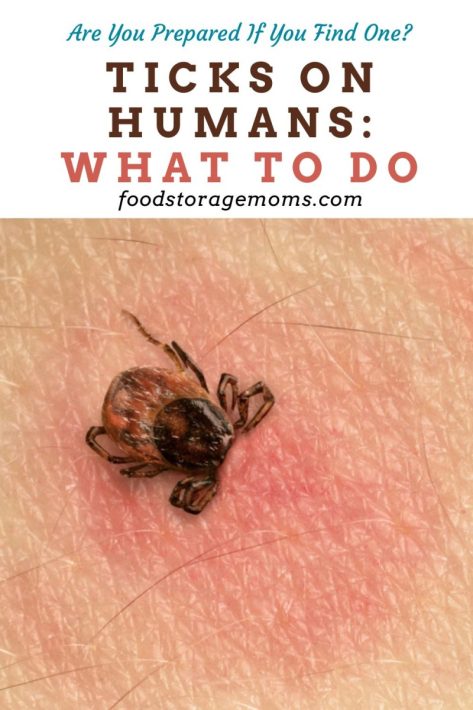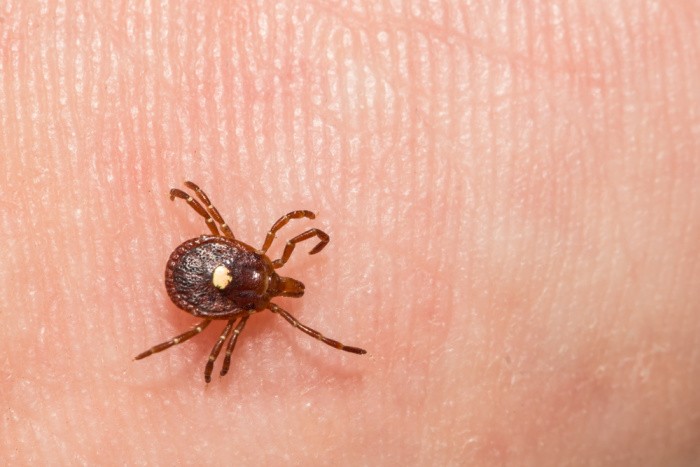Ticks On Humans: What To Do
Whether you’re out on a camping trip or spent the day hiking, sometimes a tick will come along to try and put a damper on your day. After all, when you look down and see one that’s latched on for dear life, the first thought that may be going through your head is Lyme disease. But as much of a nuisance as they can be and the fear of you catching a disease can certainly be unsettling, you don’t need to freak out. As long as you know the proper steps to remove one, you should be fine. I’d like to take a few moments to share with you what symptoms to look out for when it comes to Lyme disease, but also how to remove a tick that’s embedded into your skin the right way. Ticks on humans: what to do… Tick Kit Removal

Ticks on Humans: What to Do if You Find a Tick
For those few of you that have never had a tick on you, your day is probably coming. Do you know what proper steps to take when that happens? If your answer is no, I’d encourage you to stick around because this information could keep you or one of your loved ones from getting very sick from a tick bite.
Don’t Panic!
Although Lyme disease is a growing concern especially concerning tick bites, your chances of catching the disease are extremely low in the first 24 hours. So if you plan on camping or doing any hiking, be sure to check yourself immediately afterward instead of waiting until later. If you do happen to find one latched onto your skin, take a deep breath and try to stay calm. This will make the process a whole lot easier to properly remove it.
Have the Proper Tools
Don’t make the mistake of using your fingers to remove any unwanted tick. Doing it this way may remove the body of the tick, but the head may still be there and continue to spread harmful pathogens into your body without you realizing it. Fine-tipped tweezers are the best tool to use when removing a tick. In the past, you may remember seeing someone use a lighter or hot match tip to kill and remove a tick but this is actually not a good idea because it can cause the tick to regurgitate those same pathogens that can then cause a serious infection. There’s also the chance you can burn yourself with that method.
Proper Method to Removing a Tick
- While using tweezers, get as close to the base of the tick where it’s latched on and gently apply pressure without squeezing for best removal.
- Don’t twist or jerk the tweezers while you’re pulling upward. Doing so can cause the head or the mouth of the tick to remain behind underneath the skin even when you’ve removed its body. This can lead to a serious infection if this goes unnoticed.
- Should the head or parts of the mouth remain behind, continue to use the tweezers to remove it. If you are unable to remove everything that’s beneath the skin, thoroughly clean the area with rubbing alcohol and then finish washing with soap and warm water. It’s important to try and remove tick parts that have been left behind. You should also consider applying a strong antiseptic to try and kill any “germs” left behind. Do your best for overall best results!
- Look for any red discoloration of the skin or swelling in the area of the bite. If you see these signs, you’re better safe than sorry by going to a health professional for a check-up.
How to Dispose of a Tick
While that tick may have caused your anxiety level to kick up a few one-to-many notches, don’t try to put it out of its misery by crushing it between your fingers. Doing so can cause the tick to release and expose you to whatever pathogen or disease it may have been carrying. Instead, you can choose to flush it down the toilet or drown it in rubbing alcohol before discarding it.
Symptoms of Lyme Disease
Although Lyme disease is hardly ever life-threatening, the symptoms can be much more severe when left untreated for too long. Do you know what to look out for? These are symptoms to watch out for that are common with Lyme disease.
- Fever
- Flu-like symptoms (vomiting, chills, nausea, headache, joint aches and joint pain, tiredness, muscle aches, and stiff neck)
- Rash
- Achiness over your entire body
- Lack of energy
Symptoms of tick-borne illnesses aren’t always noticeable. Know the signs of most common tickborne diseases, so that you can stay protected. The type of tick matters and the bite of infected adult ticks can change your life forever. If you’re worried about finding ticks on humans, then know these symptoms!
Pay Attention to the Bite Site
If you start to notice a bull’s-eye rash starting to develop in the region where the tick bit you, or a few weeks later you’re getting symptoms that are common with Lyme disease, you need to head into your nearest urgent care to get evaluated. Getting an early diagnosis and the proper treatment can greatly improve the outcome. The health of you or a loved one is extremely important, so don’t wait!
Stay Away From Tick-Infested Areas
Finally, another way to avoid those ticks is to stay away from the tick-infested areas. There are many different types of ticks, so make sure you do your research! Even if there is a rumor that there are tons of ticks in the wooded area, it’s best to steer as clear as possible.
What kind of ticks exist?
- Deer tick
- American dog tick
- Blacklegged tick
- Brown dog tick
- Rocky Mountain Wood Tick
- Lone star tick
- …and many more!
What diseases do ticks cause and which ticks cause them?
If you visit the Centers for Disease Control and Prevention (CDC) at their website www.cdc.gov/ticks/diseases they have a full summary of the various diseases, the most common ticks that transmit the disease, and locations where those ticks are most often found. Here are a few:
- Anaplasmosis – blacklegged tick – northeastern and upper midwestern U.S.B
- Babesiosis – blacklegged tick – northeast and upper midwest
- Colorado tick fever – Rocky Mountain wood tick – Rocky Mountain states at elevations from 4,000 to 10,500 feet
- Heartland virus – Lone Star ticks – midwestern and southern states
- Lyme disease – blacklegged and western blacklegged ticks – northeastern U.S., upper midwest, and Pacific Coast
- Rocky Mountain spotted fever – American dog tick, Rocky Mountain wood tick, brown dog tick – More often in the Rocky Mtn. region
Can my dog get sick from tick bites?
A number of the diseases listed above can also be contracted by dogs. Lyme disease seems to be the most common tick-borne disease in the U.S. They are known to be infected by blacklegged and deer ticks. Symptoms of Lyme disease found in dogs are fever, lameness, swollen joints and lymph nodes, and exhibiting lethargy. The symptoms usually show up withing 36-48 hours. Each time you go near grassy and wooded areas with your dog, be sure to check for and remove any ticks you find.
Follow Precautions for Tick Prevention and Disease Control
- The best way to avoid ticks is by wearing insect repellent with Deet as an ingredient and avoiding heavily wooded areas.
- Wear light-colored clothing.
- Wear long-sleeved shirts.
- Always wear long pants, high-in-the-calf socks, and boots or high-top shoes.
- When checking for ticks be sure to look closely in the groin and armpit areas of the body since the ticks like the warmth found there.
More Tips for Pests
Final Word
For those of you that have a love for the outdoors, the likelihood of you getting a tick bite is much higher, but don’t fret! You’ll have nothing to worry about when following the tips I have mentioned above. Don’t take any chances with your health, especially when it comes to a tick on humans. Do you have any other helpful advice for those that may have come across a tick on them? I’d love to hear your thoughts in the comment section below. Don’t forget about your pets, check out this first aid kid for pets! May God Bless this world, Linda
Copyright Images: Tick Bite Depositphotos_53022467_S, Lone Star Tick Depositphotos_565635692_S






















Timely
Just pulled a Rocky Mountain tick off my stomach day before yesterday.
Me and the boy got into seed ticks many years ago. Had hundreds on our scalps. Used that quell shampoo like you use for school kids with head lice and it got them good. FYI
Hi Matt, oh, wow, glad you found it and removed it! We have deer hunters here and my friends have shown me how to remove them. I can’t imagine hundreds on your head, I’m starting to itch just thinking about it. The good thing is, you knew how to get rid of them. Thank you for sharing about the Quell shampoo! Linda
I’m from the west but we moved to Tennessee and even in our back yard, we’ve had ticked on us just mowing the lawn near trees or going into our creek area. I found out from the local folks who have lived here their whole lives that there are actual tick removers. We now have one in our first aid kit. Here’s a link to them. https://amzn.to/3OUFAbT
Hi Becky, oh my gosh, thank you for sharing that link. I added it to the post. I am going to order one for my first aid kit, thank you, Linda
This is an important issue and thank you for addressing it. Our oldest who will be 44 soon has had Chronic Lyme diseases once she was 19. Tested 3 times in 3 different states before finding a Lyme literate doctor. She has heart damage and has had mental health issues from it.
If anyone removes an imbedded tick, save it for future testing. Also, do not rely on essential oils and other “natural” suggestions. They will not protect you. Permethrin is really to best defense besides dressing as you suggested.
Hi Marilynne, oh my gosh, thank you for sharing this VITAL INFORMATION! It’s so frustrating to have your daughter be misdiagnosed time and time again. I love the idea of saving the tick for future testing. I’m so sorry she has heart damage and mental health issues from it. This is even more scary than I had realized. I knew the tick had to be completely removed. We all know that. But, we must be diligent in getting it tested to be sure the family member gets correctly diagnosed. I am a mother and grandmother, I cannot even imagine the frustration you have gone through. My heart aches for you and your daughter. God bless you and your daughter, hugs and love, Linda
Thank you, Linda❤️
Becky,
Thank you so much for the link!! I just ordered 2, 1 for my son & 1 for us. Much appreciated!!
Linda, I really love foodstoragemoms! Thanks for all the valuable info & suggestions!!
Hi Kimberlee, oh, thank you for your kind words! We all learn from each other! Life is good! Linda
You’re very welcome.
One of the highlights of being married … is having someone to remove that tick, you just can’t reach. LOL
Hi Leam, now I have the giggles, I LOVE THS COMMENT! Life is good! Linda
Ticks really gross me out!
Hi Jess, now I have the giggles! I think they gross everyone out! Linda
Ice….They release their grasp and you can pull right off. Heat makes them dig in…!!!
Hi Rooster C, ice, that’s a great tip, thanks for sharing. Ice they release, heat they dig in! I love learning new things,! Linda
Opposite for slugs and leeches, you probably alteady know that though…
Hi Rooster C, no I did not know that, thank you for sharing. Linda
We have a product called “Tick Key” and they work great. Husband is a tick magnet, not chick magnet! LOL. He and I can walk through wooded areas and he will have ticks and I don’t. Mosquitos don’t like me either!
Hi Paula, wow, you are the lucky one! I will check out the Tick Key! I love learning about stuff! Linda
Please add Alpha-Gal syndrome to this. Not only does the Lone Star tick can cause Heartland virus, but they can cause Alpha-Gal syndrome, which makes you allergic to all mammal and mammal byproducts, including anti-venom, some medications which include gelatin. Please add this to your information. It can cause Hives, breathing problems, and anaphylaxis. My husband has this and it has been a lot of research to keep him healthy. Just read that if you can remove the tick right away, the sugar protein that the tick emits will not make into your system.
Hi Carla, oh my goodness, I just did a little research on Alpha-Gal syndrome, yikes! Thank you for making us aware of it. Linda